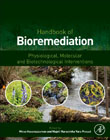
Handbook of Bioremediation: Physiological, Molecular and Biotechnological Interventions
Hasanuzzaman, Mirza
Prasad, Majeti Narasimha Vara
Handbook of Bioremediation: Physiological, Molecular and Biotechnological Interventions discusses the mechanisms of responding to inorganic and organic pollutants in the environment using different approaches of phytoremediation and bioremediation. Part One focuses specifically on inorganic pollutants and the use of techniques such as metallothionein-assisted remediation, phytoextraction and genetic manipulation. Part Two covers organic pollutants and consider topics such as plant enzymes, antioxidant defense systems and the remediation mechanisms of different plant species. This comprehensive volume is a must-read for researchers interested in plant science, agriculture, soil science and environmental science. The techniques covered in this book will ensure scientists have the knowledge to practice effective bioremediation techniques themselves. Provides a comprehensive review of the latest advances in bioremediation of organic and inorganic pollutantsDiscusses a range of different phytoremediation techniquesEvaluates the role of genomics and bioinformatics within bioremediation INDICE: 1. Concept and types of bioremediation 2. The use of industrial and food crops for the rehabilitation of contaminated areas with metal(loid)s: physiological and molecular mechanisms of tolerance 3. Mechanistic overview of metal tolerance in edible plants: A physiological and molecular perspective 4. Phytoextraction of heavy metals by weeds: Physiological and molecular intervention 5. Phytomanagement of As-contaminated matrix: Physiological and molecular basses 6. Physiological and molecular mechanism of metal chelation and phytoextraction 7. Metallothionein -assisted remediation 8. Phytochelatins and their relationship with modulation of cadmium tolerance in plants 9. Thiol-dependent metal hyperaccumulation and tolerance in plants 10. Role of redox system in enhancing phytoremediation capacity in plants 11. Hormonal regulation in enhancing metal/metalloid tolerance in plant: A basis of phytoremediation 12. Role of reactive nitrogen species in enhancing metal/metalloid tolerance in plant: A basis of phytoremediation 13. Interplay between Selenium and Mineral Elements to Improve Plant Growth and Development 14. Phytoremediation and physiological mechanisms of metal resistance of plants of the tidal zone of the White Sea coast 15. Physiological basis of aquatic plants in accumulating arsenic from soil and water 16. Alteration of plant physiology by the application of biochar for remediation of metals 17. Role of glutathione in enhancing metal hyperaccumulation in plants 18. Physiological and molecular basis of bioremediation of radionuclides 19. Physiological and molecular basis of bioremediation of micropollutants 20. Plant-Microbe Interaction: Relevance for phytoremediation of Heavy metals 21. Molecular basis of arbuscular mycorrhizal fungal-plants interaction in remediation of potentially toxic metals 22. Prospective use of efficient resistant plant growth promoting rhizobacteria in biofertilization and phytoremediation of heavy metal contaminated soil 23. Role of Secondary Metabolites in Salt and Heavy Metal Stress Mitigation by Halophytic Plants: An Overview 24. Genetic basis of metal hyperaccumulation 25. Antioxidant defenses system and bioremediation 26. Gene regulation in halophytes in conferring salt tolerance 27. Recent advances toward exploiting medicinal plants as phytoremediators 28. Can plants be considered as phytoremediators for desalination of saline wastewater: a comprehensive review 29. Genomics in understanding bioremediation of inorganic pollutants 30. Genetic engineering of plants to tolerate toxic metals and metalloids 31. Metal-binding proteins and peptides in bioremediation and phytoremediation of heavy metals 32. Bioremediation of heavy metals using the symbiosis of hydrophytes and metal resistant bacteria 33. Bioremediation of heavy metals using symbiosis between leguminous plants and genetically engineered rhizobia 34. Plant enzymes in metabolism of organic pollutants 35. Alteration of plant physiology by the application of biochar for remediation of organic pollutants 36. Role of reactive nitrogen species in mitigating organic pollutants-induced plant damages 37. Antioxidant defenses system in bioremediation organic pollutants 38. Role of redox system in enhancing remediation of organic pollutants in plants 39. Role of glutathione in enhancing plants tolerance to organic pollutants 40. The role of plant species in phytoremediation of wastewater contaminated with phenolic compounds and fuel hydrocarbons 41. Physiological and molecular basis for remediation of polyaromatic hydrocarbons 42. Physiological and molecular basis for remediation of pesticides 43. Environmental concerns associated with explosives (HMX, TNT, RDX), heavy metals and metalloids from shooting range soils: prevailing issues, leading management practices, and future perspectives 44. Physiological and molecular basis of plants' tolerance to linear halogenated hydrocarbons 45. Molecular basis of plant-microbes interaction in remediating organic pollutants 46. Microbial degradation of organic pollutants using indigenous bacterial strains 47. Molecular basis of plant-microbes interaction in remediating pesticides 48. Molecular basis of arbuscular mycorrhizal fungal-plants interaction in remediation of xenobiotics 49. Transgenic plants - potential tool for the decontamination of organic pollutants 50. Biodegradation of explosives by transgenic plants 51. Preparation of plants containing bacterial enzyme for degradation of polychlorinated biphenyls 52. Remediation of organic pollutants by Brassica species 53. Bioremediation of organic contaminants based on biowaste composting practices 54. Bioremediation of textile dyes using Ferns 55. Nanobioremediation: An innovative approach for environmental safety 56. Phytotoxicity and remediation strategies of nanomaterials 57. Bioinformatic tools in understanding the molecular basis of phytoremediation of metals and other inorganic/organic pollutants
- ISBN: 978-0-12-819382-2
- Editorial: Academic Press
- Encuadernacion: Rústica
- Páginas: 650
- Fecha Publicación: 01/10/2020
- Nº Volúmenes: 1
- Idioma: Inglés
